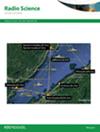Variation in the reflection height of VLF/LF transmitter signals in the D-region ionosphere and the possible source: A 2018 meteoroid in Hokkaido, Japan
IF 1.6
4区 地球科学
Q3 ASTRONOMY & ASTROPHYSICS
引用次数: 0
Abstract
Several studies have examined ionospheric variation associated with meteorites, meteoroids, or meteors based on Global Satellite Navigation System total electron content observations. However, there have been few quantitative studies of the D-region of the ionosphere (60–90 km), which is associated with meteoroids. We investigated variation in the D-region during the passage of a meteoroid over northeastern Hokkaido, Japan, at 11:55:55 UT on 18 October 2018, using very low-frequency (VLF, 3–30 kHz) and low-frequency (LF, 30–300 kHz) signals observed by three transmitters [JJY (40 kHz), JJY (60 kHz), and JJI (22.2 kHz)], at Rikubetsu, Japan. Periodic variation of 100–200 s was observed in the VLF and LF amplitudes upon arrival of the acoustic wave. The vertical seismic velocity of Hi-net and F-net data also showed acoustic waves. Although the main period of the acoustic wave was 0.1–0.5 s in the seismic data, a longer period component (100–200 s) remained during propagation up to the D-region ionosphere. The estimated velocity of the acoustic waves was ∼340 m/s on the ground according to the Hi-net seismic data. The acoustic wave originated near the endpoint (25 km altitude) of the meteoroid trajectory. Based on the observed propagation time of the acoustic waves and ray tracing results, the acoustic waves propagated obliquely from near the endpoint of the meteoroid trajectory up to a D-region height (about ∼90 km altitude), south of the Rikubetsu receiver.D 区电离层中 VLF/LF 发射机信号反射高度的变化及其可能来源:2018 年日本北海道的一颗流星体
一些研究根据全球卫星导航系统的电子总含量观测结果,对与陨石、流星体或 流星体有关的电离层变化进行了研究。然而,对与流星体有关的电离层 D 区(60-90 公里)的定量研究却很少。我们利用日本陆别市的三个发射器[JJY(40 kHz)、JJY(60 kHz)和 JJI(22.2 kHz)]观测到的甚低频(VLF,3-30 kHz)和低频(LF,30-300 kHz)信号,研究了 2018 年 10 月 18 日 11:55:55 UT 时一颗流星体经过日本北海道东北部上空时 D 区的变化。在声波到达时,VLF 和 LF 振幅出现了 100-200 秒的周期性变化。Hi-net 和 F-net 数据的垂直地震速度也出现了声波。虽然在地震数据中声波的主要周期为 0.1-0.5 秒,但在向 D 区电离层传播的过程中仍存在一个较长的周期分量(100-200 秒)。根据 Hi-net 地震数据,声波在地面上的速度估计为每秒 340 米。声波起源于流星体轨迹终点(25 公里高度)附近。根据观测到的声波传播时间和射线追踪结果,声波从流星体轨迹的端点附近斜向传播到 D 区高度(约 ∼ 90 千米高度),位于 Rikubetsu 接收器的南面。
本文章由计算机程序翻译,如有差异,请以英文原文为准。
求助全文
约1分钟内获得全文
求助全文
来源期刊

Radio Science
工程技术-地球化学与地球物理
CiteScore
3.30
自引率
12.50%
发文量
112
审稿时长
1 months
期刊介绍:
Radio Science (RDS) publishes original scientific contributions on radio-frequency electromagnetic-propagation and its applications. Contributions covering measurement, modelling, prediction and forecasting techniques pertinent to fields and waves - including antennas, signals and systems, the terrestrial and space environment and radio propagation problems in radio astronomy - are welcome. Contributions may address propagation through, interaction with, and remote sensing of structures, geophysical media, plasmas, and materials, as well as the application of radio frequency electromagnetic techniques to remote sensing of the Earth and other bodies in the solar system.
 求助内容:
求助内容: 应助结果提醒方式:
应助结果提醒方式:


